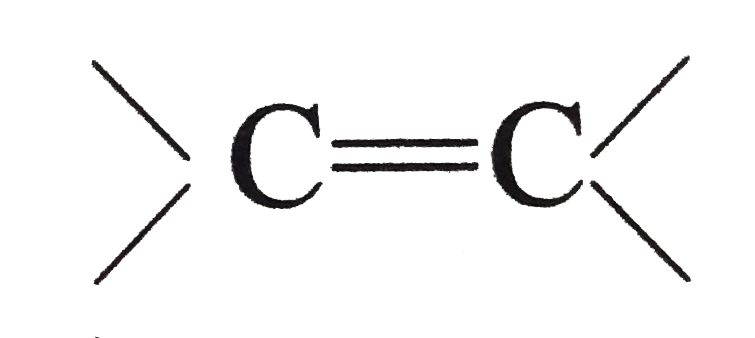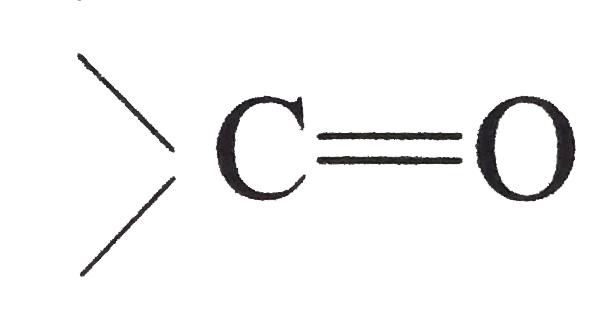Explain the following with proper reasonin
(i) Why do halogen acids which are easily added to 
(ii) Pure HCN fails to react with aldehydes.
(iii) Why only RCHO, RCOCH3 and cyclic ketones react with NaHSO3?
(iv) Chloral hydrate is a stable compound even it is a gem-diol.
(v) Formation of oximes and other ammonia derivatives from carbonyl compounds require slightly acidic media for maxiumum rate
(vi) In the following reaction, three isomers are present in the equilibrium which is most stable

(vii) teh strurcture of two isomeric oximes formed by the reaction of acetophenon with hydroxylamine hydrochloride.
(viii) Why o-hydroxy benzaldehyde is a liquid at room temperature while p-hydroxy benzaldehyde is high metling solid?
Text Solution
(i) Halogen acids readily combine to the polarised 

The addition product being similar to gem-dihydroxyle compound decomposes into the original substance 
(ii) HCN is a covalent compound an does not furnish CN− ions. However, in the presence of bases, it furnishes sufficient concentration of CN− ions and the reactionproceeds.
HCN+OH−→H2CN−
(iii) SO2−3 is a large ion. Its addition is possible only under the condition that  grouping is not sterically hindered as is the case for RCHO RCOCH(3) and cyclic ketones
grouping is not sterically hindered as is the case for RCHO RCOCH(3) and cyclic ketones
(iv) In chloral, the -I effect of three chlorine atoms destabilise the  structure as it uts δ+ charge on the carbon adjacent to the carbonyl δ+C. In the chloral hydrate, adjacent positive charges are not present. AS a result, weak nucleophiles like water readily add to the
structure as it uts δ+ charge on the carbon adjacent to the carbonyl δ+C. In the chloral hydrate, adjacent positive charges are not present. AS a result, weak nucleophiles like water readily add to the  group formin chloral
group formin chloral
hydrate there by shifting the equilibrium almost entirely towards right. Besides this, the intramolecular H-bonding between Cl and H atom of the -OH group further stabilies the chloral hydrate molecule. The hydrogen bonding in the molecule also increases its stability 
(v) In weakly acidic medium, carbonyl group is protonated,

Thsi faciliates the addition of Lewis bases. However, is strongly acidic media, the nitrogen of the reagent is protonated through the unshared pair of electrons and thus the reagent attack the carbonyl group. In basic, media, there is no protonation of carbonyl group.
(vi) Crotonaldehyde is most stable, sicneit is a conjugated aldehyde.
(vii) 
(viii) o-Hydroxy benzaldehyde involves intramolecular hydrogen bonding, hence it is a liquid because its intermolecular forces is low. On the other hand, p-hydroxy benzaldehyde involves intramolecular hydrogen bonding and therefore, it is a soilid.


|
Topper's Solved these Questions
- ALDEHYDES AND KETONES BOOK - OP TANDONCHAPTER - ALDEHYDES AND KETONES EXERCISE - MATCHING TYPE
1 Videos
- ALDEHYDES AND KETONES BOOK - OP TANDONCHAPTER - ALDEHYDES AND KETONES EXERCISE - PROBLEMS BASED ON STRUCTURE AND PROPETIES
17 Videos
- ALDEHYDES AND KETONES BOOK - OP TANDONCHAPTER - ALDEHYDES AND KETONES EXERCISE - ILLUSTRATIONS OF OBJECTIVE QUESTIONS
12 Videos
- ALCOHOLS, PHENOLS AND ETHERSBOOK - OP TANDONCHAPTER - ALCOHOLS, PHENOLS AND ETHERSEXERCISE - SINGLE INETER ANSWER TYPE QUESTIONS / ALCOHOLS AND PHENOLS
15 Videos
- BASIC PRINCIPLESBOOK - OP TANDONCHAPTER - BASIC PRINCIPLESEXERCISE - SECTION V INTEGER ANSWER TYPE QUESTION
3 Videos
Similar Questions
Knowledge Check
Which of the following react with NaHSO3
ACH3COCH3BCH3CHOCHCHODAll of these
Aldehydes and ketones react with ammonia derivatives in weakly acidic/strongly acidic medium.
View SolutionWhy is it necessary to control the pH during the reaction of aldehydes and ketones with ammonia derivatives?
View SolutionWhy is it necessary to control the pH during the reaction of aldehydes and ketones with ammonia derivatives?
View SolutionNaHSO3 is used for the purification of carbonyl compounds. Explain.
View SolutionNaHSO3 is used for the purification of carbonyl compounds. Explain.
View SolutionChloral hydrate is a gem-diol but still stable. How will you account for it ?
View SolutionChloral hydrate is a gem-diol but still stable. How will you account for it ?
View Solution
